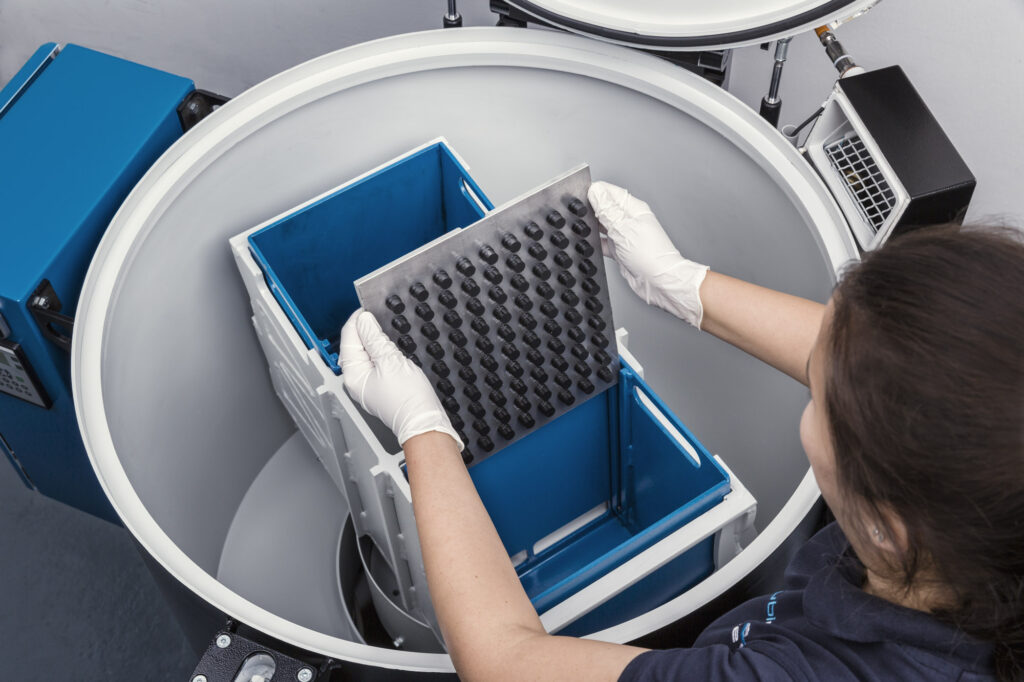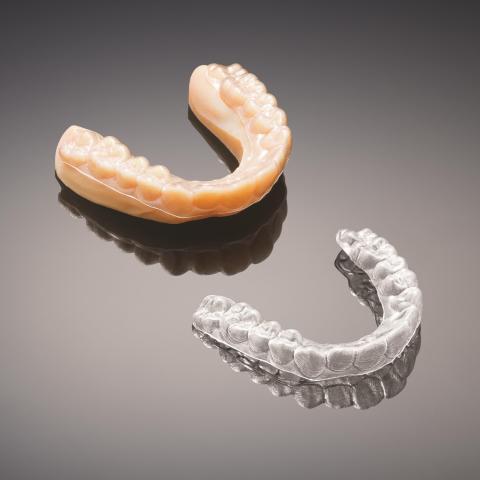The recent acquisition of Cubicure by American dental giant Align Technology sent a palpable shockwave through the industry, yet in many ways, it was a move that made perfect sense. Align Technology has been in a long-standing collaboration with 3D Systems, spanning over 25 years, focused on creating molds for its invisible aligners. While the numbers are subject to some variation, it’s estimated that Align Technologies produces about a million 3D printed aligners daily, a figure that nearly matches the combined output of its competitors. This speaks to the significant and enduring role that 3D printing has in the production of dental aligners, a role that is now causing a seismic shift in the industry.
What Happened?
Cubicure is a player in hot lithography, offering an all-encompassing solution that includes its own software, polymers, and vat polymerization machines. The company provides a range of production systems, from compact setups to more expansive, industrial-grade options. One of its machines boasts a build volume of 1000 x 280 x 300 mm and is capable of flashing a new layer every ninety seconds. Adding to its capabilities, Cubicure also has its own post-processing toolchain, which allows for batch-based, large-scale part production.
Why Cubicure?
By acquiring Cubicure, Align Technologies gains the capacity to work with more viscous materials, potentially leading to the use of newer and safer materials in the production process. Align’s existing portfolio of hot lithography patents suggests that the company has been actively involved in Cubicure’s area of expertise for some time. These specific patents, particularly those related to materials, indicate a deep, longstanding interest in hot lithography. The benefits of using safer resins, achieving better mechanical properties, and gaining greater accuracy could very well be compelling reasons for Align Technologies to specifically target Cubicure for acquisition over other companies.
Cubicure’s hot coating step offers additional value by allowing for specialized textures or finishes on the final product. This acquisition signals a clear move by Align Technologies to own its entire tool chain and become more vertically integrated. Various motivations could be driving this strategy—whether it’s a desire for greater control, the ability to accomplish tasks not feasible with standard vat polymerization, cost-saving measures, or possibly even a more revolutionary objective. An intriguing possibility is that Align has discovered a method to produce direct silicone aligners, effectively bypassing the need to create 3D-printed molds that are subsequently thermoformed.
More Exciting IP
Considering Align Technologies’ scale, any of the previously mentioned reasons for acquiring Cubicure would make strategic sense. However, Cubicure’s patent portfolio adds another layer of intrigue. One of their methods appears to address a significant challenge in vat polymerization—namely, how to prevent unpolymerized or excess resin from sticking to a part. This issue carries both safety and cost implications. Cubicure’s patent on centrifuging components could, by itself, give Align a competitive edge.
In addition, Cubicure holds another valuable patent that outlines a method for automatically removing support structures, a major cost factor in many SLA parts. Another patent concerns bismaleimides, which could introduce high-temperature performance to SLA parts. A cleaning patent also seems particularly useful. And while patents related to metal-infused parts may not have immediate applications, they could become valuable assets down the line. Given the potential impact of these intellectual property assets, they might have played a substantial role in Align’s decision to acquire Cubicure.
Long Term?
The acquisition of Cubicure by Align Technologies could indeed serve as a strategic lever in negotiations with 3D Systems. While the long-term prospects for 3D Systems in this relationship appear uncertain, it’s unlikely that Align would make an abrupt shift away from its long-standing partner. Developing a new, integrated manufacturing system based on Cubicure’s intellectual property could be a long-term endeavor.
In the interim, Align may find it more convenient to maintain its existing partnership with 3D Systems. The most logical path could involve a phased approach, where Align gradually introduces Cubicure technology into new product lines as they are developed. This would allow for a smoother transition and minimize any disruptions to existing operations. Consequently, it may take several years for Align to fully disengage from 3D Systems, assuming that is the ultimate goal.
Direct or Indirect?
The notion that Align Technologies would immediately switch to direct 3D printing of aligners following the Cubicure acquisition is a tempting, albeit hasty, conclusion to draw. Align operates at a massive scale and holds a significant brand value that it would be hesitant to risk by introducing untested processes or materials into its product line. Changing core business processes for a company of Align’s magnitude is no small feat and could be fraught with unforeseen challenges.
Additionally, concerns about the safety of 3D-printed materials coming into contact with the oral cavity would likely add a layer of caution to such a switch. While it might appear cost-effective and straightforward to 3D print the aligners directly, the potential risks, especially those related to photoinitiators or other materials leeching into the mouth, could make this approach less desirable. Given these factors, it’s reasonable to assume that any shift towards direct 3D printing of aligners, if it occurs at all, would be a gradual one. Align has much to consider in terms of safety, scalability, and operational efficiency before making such a significant change.
Profit? Cost cutting?
Currently Align´s operating margins are at 15% and its net is at 8%. Its net margins have been eroding, halving when compared to a few years ago while operating margins are ten percent lower than a decade ago. Now this is not the kind of stuff to make investors happy. Align may want to do some work ¨transforming smiles¨ on Wall Street as well as on its customers. Share prices are also half of what they were in 2021 and while most are predicting rises they are modest when compared to highs. Now in line of this paying less for resin and machine time would ameliorate their situation and give them breathing room.
New Innovations
An acquisition could potentially energize Align’s innovative initiatives. The company holds a patent for a custom aligner capable of releasing fluid, paving the way for at-home treatments like teeth whitening and gingivitis care. Imagine a localized mouthwash or a revolutionary way to brush your teeth. Align also owns a patent for an advanced aligner that utilizes 3D printing and meta-materials for enhanced performance. This could offer more precise treatments, providing an edge over competitors. Another patent in Align’s portfolio explores the incorporation of sensors within aligners. These sensors, which could potentially be created using hot lithography, would not only differentiate Align’s offerings but also expand the range of treatments to include solutions for teeth grinding, sleep aids, and even athletic mouth guards. Importantly, the addition of sensors could enhance the overall functionality of the devices.
Conclusions
The news appears unfavorable for 3D Systems in the long run. While Align may have made the acquisition primarily for cost savings and bolstering margins, the purchase of Cubicure is about more than just vat polymerization. Align has been involved in hot lithography for years, and it seems there are advantages to this technology in particular and more viscous materials in general for producing safer, better aligners. Cubicure’s additional intellectual property could also be operationally beneficial for Align. The company is among a handful offering production solutions in vat polymerization, making it a rare asset.
That said, tough times for startups could lead to acquisitions by firms like Phonak, Starkey, and Siemens. It’s important to note that 3D printing is a $15 billion industry, whereas companies like Align, Sonova, and Starkey have revenues of $3.7 billion, around $3 billion, and $2 billion respectively. When focusing on just aligners and hearing aids, some of these firms generate revenues that are a sizable fraction of the entire 3D printing industry. This serves as a reminder that 3D printing is often more impactful as a catalyst for other sectors rather than as an isolated industry.
While the 3D printing community has long been convinced of its revolutionary potential, the real value may lie in enabling other industries to achieve their goals. By embracing the applications and the companies driving them, the 3D printing sector may find its most significant contributions are in service to broader markets.
Subscribe to Our Email Newsletter
Stay up-to-date on all the latest news from the 3D printing industry and receive information and offers from third party vendors.
You May Also Like
3D Printing Webinar and Event Roundup: April 21, 2024
It’s another busy week of webinars and events, starting with Hannover Messe in Germany and continuing with Metalcasting Congress, Chinaplas, TechBlick’s Innovation Festival, and more. Stratasys continues its advanced training...
3D Printing Webinar and Event Roundup: April 14, 2024
We’re starting off the week’s 3D printing webinars and events at ASTM AMCOE’s 11th Snapshot Workshop and MACH Exhibition. Stratasys continues its advanced training courses, SME is holding a virtual...
Polly the Duck to Receive 3D Printed Bill Prosthetic
In Williamson County, Texas, a story of resilience, innovation, and cross-community effort is unfolding, illustrating the bond between humans and wildlife. All Things Wild, a wildlife rehabilitation center, has been...
3D Printing News Briefs, April 3, 2024: Kickstarter FDM 3D Printer, Artificial Eyes, & More
In 3D Printing News Briefs today, we’re talking about an FDM 3D printer on Kickstarter, advancements in artificial eye creation, and 3D printed solenoids for electromagnets. Then we’ll move on...



































